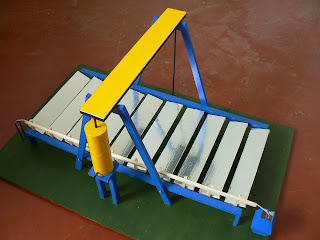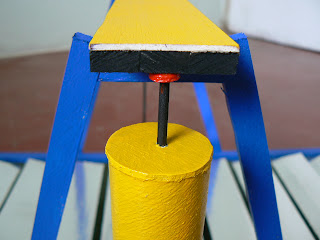
I´ve assembled a small scale model of the water pasteurization system that we hope to test in June or July. I´m trying to identify an organization that has experience with other water projects and has a presence in a sunny rural area where we can install it. My friend Larry Winiarski Jr. (whose father invented many of the stove and oven designs that I´ve been implementing) has invented a way to make a very inexpensive solar concentrator using strips of aluminized mylar stretched tightly in metal frames, and ganged together to track the sun. It could just as well be used as an economical way to increase the output of a solar electricity generator, which is the application he originally had in mind for it.

My contribution to the design is a yet-to-be-proven control system that uses an odd-shaped bucket of water with a slow leak, where a floating weight tied to the control arm falls at a varying velocity during the day to precisely follow the motion of the sun. (I haven´t yet calculated the exact shape of the bucket required, but it´s represented in the model by a sort of diamond shaped bucket, which is a very rough approximation of the needed shape).
This device takes advantage of the fact that purification of water doesn´t require boiling, but only pasteurization. That is, as long as the temperature is held at a certain temperature for a certain amount of time, all of the dangerous bacteria and viruses will be killed. The amount of time varies inversely with the temperature, but the absolute minimum is 65 degrees C, at which pasteurization requires about 30 minutes. Raising the temperature of water from room temperature to 65 degrees C requires only
half as much energy as boiling the water! But holding it at that temperature requires either the expenditure of more energy or the use of a well insulated container.

In the aquaflector system (so named by Larry), the untreated water enters one end of a shallow, wide heating duct that is suspended about 4 meters above the ground. The top of the duct is covered with insulation, and the reflectors concentrate the sunlight on the bottom of the duct to heat the water. At the far end of the duct is an exit pipe with an automotive thermostat (the little red thing between the water duct and the retention tank) that opens at 71 degrees C. The heated water enters an insulated retention tank that has been sized to hold about half an hour´s output, and the bottom of the tank contains an exit pipe connected to a float valve so that when the tank is full, the coolest, densest water (which has spent the most time in the tank) is released for use.
A further improvement to the design which I haven´t yet reflected in the model is the use of a heat exchanger to improve the efficiency of the system. ¨Waste heat¨ from the treated water will be used to preheat the untreated water, increasing the output of the system by a factor of two or three.
 From what I´m told by people here in Chorrillos, their mayor is a pretty good one. He hasn´t been seriously accused of corruption, and has been reelected twice. And every once in a while he has a really good idea, but sometimes the execution is a little lacking -- like the Ciclovía (cycle path) that was recently put into place. Traffic is heavy in most parts of the city from dawn to dusk, and lots of bicyclists have been killed by careless drivers. So a separate traffic lane for bicycles could have a big impact on safety and encourage more people to use bicycles, reducing auto traffic.
From what I´m told by people here in Chorrillos, their mayor is a pretty good one. He hasn´t been seriously accused of corruption, and has been reelected twice. And every once in a while he has a really good idea, but sometimes the execution is a little lacking -- like the Ciclovía (cycle path) that was recently put into place. Traffic is heavy in most parts of the city from dawn to dusk, and lots of bicyclists have been killed by careless drivers. So a separate traffic lane for bicycles could have a big impact on safety and encourage more people to use bicycles, reducing auto traffic. of the busiest bus stops in the city, are going to pay much attention to the new yellow lines. So while there will undoubtedly be a reduction in the number of bicyclists run over by vehicles, there will probably be an increase in the number of pedestrians run over by bicycles. I suppose it´s a good tradeoff.
of the busiest bus stops in the city, are going to pay much attention to the new yellow lines. So while there will undoubtedly be a reduction in the number of bicyclists run over by vehicles, there will probably be an increase in the number of pedestrians run over by bicycles. I suppose it´s a good tradeoff.
 I´ve assembled a small scale model of the water pasteurization system that we hope to test in June or July. I´m trying to identify an organization that has experience with other water projects and has a presence in a sunny rural area where we can install it. My friend Larry Winiarski Jr. (whose father invented many of the stove and oven designs that I´ve been implementing) has invented a way to make a very inexpensive solar concentrator using strips of aluminized mylar stretched tightly in metal frames, and ganged together to track the sun. It could just as well be used as an economical way to increase the output of a solar electricity generator, which is the application he originally had in mind for it.
I´ve assembled a small scale model of the water pasteurization system that we hope to test in June or July. I´m trying to identify an organization that has experience with other water projects and has a presence in a sunny rural area where we can install it. My friend Larry Winiarski Jr. (whose father invented many of the stove and oven designs that I´ve been implementing) has invented a way to make a very inexpensive solar concentrator using strips of aluminized mylar stretched tightly in metal frames, and ganged together to track the sun. It could just as well be used as an economical way to increase the output of a solar electricity generator, which is the application he originally had in mind for it.



